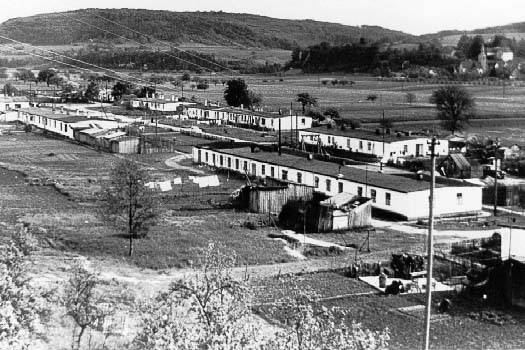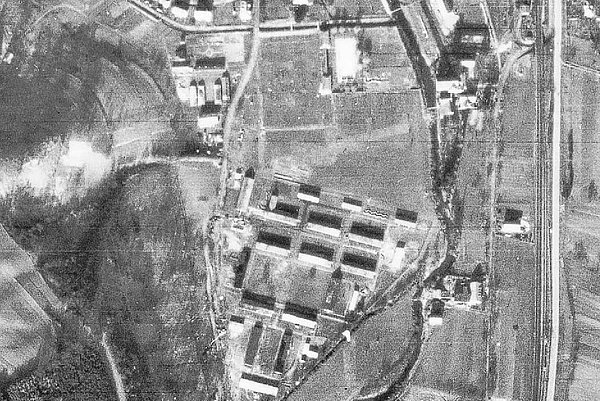The Forced Labour Camp in The Elz Estuary
Forced Labour in Nazi Germany
In Hitler´s Nazi Germany, forced labour was pervasive, especially in the second half of the war when all those Germans who were fit for military service were already deployed.
The forced labourers were recruited from abroad. Initially they attempted to aquire workers in those countries that were linked to Nazi Germany (Italy, Vichy-France...) or in those occupied eastern countries.
When the recruitment failed to deliver enough people, the Nazi offices resorted to more and more coercive measures: Not only were entire age groups of young men obliged to join the German workforce, but both men and women were forcefully abducted from the streets.
The forced labourers were treated very differently, depending on their origins and their status. The Nazis´ race criteria would be implemented to accomplish this. "Western workers" had it better than "Eastern labourers". In addition, prisoners of war, convicts and concentration camp prisoners were forced to work.
Agricultural workers would often be assigned to families. The industrial workers, both male and female, lived in the camps that were managed by the labour administration, the Wehrmacht (armed forces) or other offices. The concentration camp prisoners and the SS-convicts were subordinated to the SS.
Forced Labourer in Genshagen
In the 1930´s the Daimler-Benz engine plant in Genshagen exclusively employed German "loyal followers" (the Nazi expression for "workforce or staff"). During the course of the war, they were gradually replaced by "foreign workers" from various European countries. This occured as the German workers were conscripted to the Wehrmacht (armed forces).
At the same time, the production was divided into individual steps. This enabled the engine production to be completed on an assembly line. The result was, that less qualified workers could nevertheless produce more engines.
Forced Labour Camp in the Elz Estuary
When the mechanical production of the engine components was transferred from Genshagen to the gypsum mine in Obrigheim in 1944, thousands of workers (both male and female) moved to the Neckar. It is estimated that two thirds of these workers were either foreign or forced labourers.
They were housed in numerous camps in the entire region. Some of these camps were set up in seized permanent buildings (including once again, schools and gyms); other camps had to be initially set up by the concentration camp prisoners. Attempting to create enough lodgings for Daimler´s "loyal followers" proved to be one of the biggest problems for the "Goldfish" relocation project. It was planned that 7,000 labourers be transferred - this goal was never attained.
A few examples of the forced labour camps:
"Hohl" Camp
The "Hohl" camp was located west of the Reichsstraße 27 where today´s Neckarelz industrial park (Hornbach etc) can be found. It was near the Neckar, not far from the railway bridge that led to the "'Goldfish" gallery. It was originally planned for 1,400 "Eastern workers", but in reality there were only around 900. A small prison camp for Italian military internees was another addition. The barracks were made of prefabricated concrete elements and were put together by the concentration camp prisoners from the "SS-command - barrack construction".
After the war, and the end of Nazi Germany, the camp barracks were used as lodgings for those who had been displaced or expelled from their home countries.
The "Hammerweg" Camp
Construction of the SS-prison camp on the Mosbach Hammerweg began in the summer of 1944, by concentration camp prisoners from the Neckarelz camp. It housed hundreds of SS-men, who as a result of violations of SS rules were themselves sentenced to forced labour.
One of the prisoners was Rudolf Kuhnig. He would later recall:"We would always march on foot to the gypsum mine. We had to march just like the military, always in rows of three. Every troop consisted of 200-220 men. Every shift had 400 men.... We did not work side by side with the concentration camp prisoners in the gallery. We had to operate the machines, not them."
"Italian Camp"
The old Wilhelm-Stern-Elementary School along with the gym located near the old Mosbach train station, served as the lodgings for the Italian military internees. As a result of the relatively long distance (around 5km), the Italian forced labourers took the train to the "Goldfish" gallery.
"Heimschule" Camp
The "Heimschule" camp was located in a building of the present day Johannes-Diakonie. In May 1944, it had provided for an occupancy of initially 500 workers. Later on, it was to be increased to 1,200 places. There were women in this camp, for whom new barracks were constructed.
Seven hundred "Goldfish" workers were housed in the Mosbach "Heimschule" from August 1944. A conversion of the attic made room for an additional 180 beds. By September 1944, additional barracks extended the Mosbach camp and expanded its capacity to 1,000 places.



